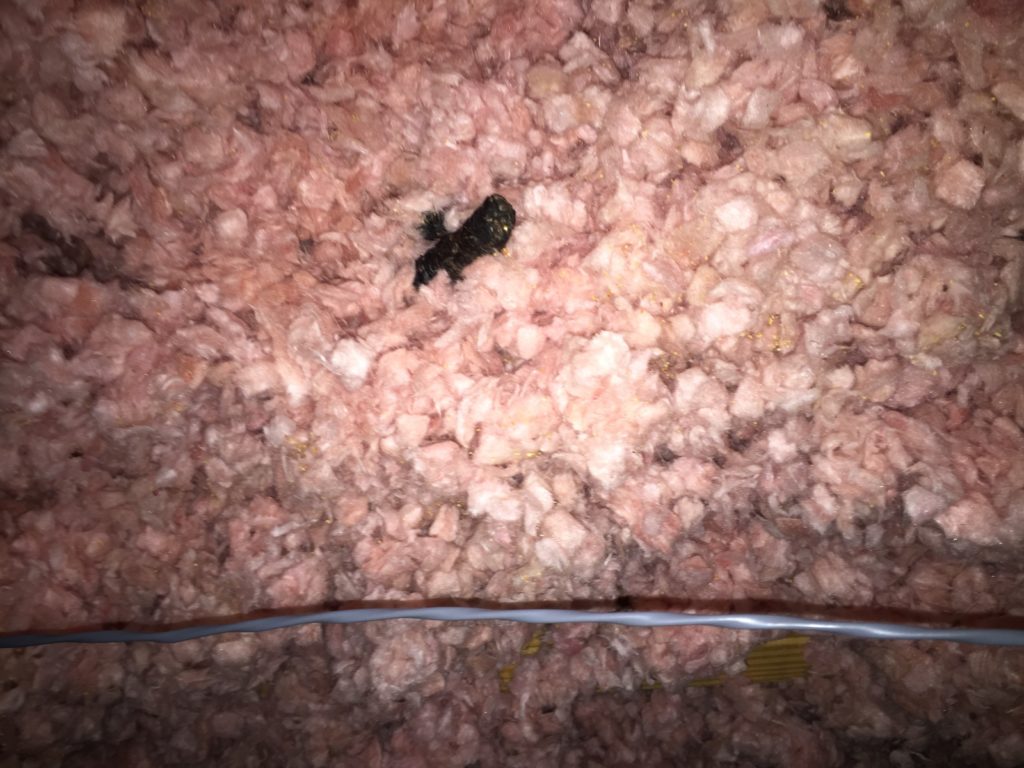What does it look like?
Fecal matter produced by raccoons is tube-shaped, about 2-3 inches long, and runs slightly smaller than the diameter of a hot dog. In general, adult raccoon feces closely resemble dog feces. However, one very important distinction of raccoon feces is the presence of undigested food remnants scattered throughout the feces.
For example, if a raccoon has been eating berries, its feces will be reddish-brown and will contain undigested seeds from the berry that was consumed, thus giving the fecal matter the appearance of being speckled with berry seeds. If the raccoon was eating corn, kernels will appear in the feces similar to what shows up in human feces after eating corn.
Raccoons frequently defecate and urinate in the same place and generate piles of feces called raccoon latrines. Raccoon latrine locations include tree bases, stumps, garages, under decks, and attics.

Raccoon Feces & Urine – Do they cause disease?
The most widely known disease transmitted to humans or pets by raccoons is rabies. However, raccoon feces are not involved with rabies since this disease is typically associated with saliva contact from a rabid animal’s bite or scratch. However, raccoon feces and urine are associated with other known diseases, including roundworm, giardia and leptospirosis.
Raccoon Roundworm
Raccoon roundworm, or Baylisascaris procyonis, parasitizes a raccoon’s intestines, and the worm’s eggs show up in the raccoon’s feces. People and pets who unknowingly ingesting roundworm eggs may become infected. Symptoms may vary, but include loss of muscle control, liver complications, fatigue and blindness if the eyes are affected.
Giardia
Giardiasis is an infection that can be transmitted by many animals, including raccoons. Raccoons can carry this organism in their feces and can contaminate water, soil and any surface that Giardia may contact. Humans become infected by ingesting the infective cysts in the raccoon’s feces, of which produces the symptoms of nausea, abdominal cramps, diarrhea and dehydration.
Leptospirosis
Leptospirosis is a bacterial infection that many animals, including raccoons, can transmit. Raccoons excrete the disease-causing organism in their urine. While leptospirosis does not involve raccoon feces, it is important to know that the possibility of contracting this disease is one more reason to be concerned about raccoons and their associated bodily wastes. Symptoms include aching muscles, headache, high fever, jaundice and diarrhea. In some cases, infections may be mild or show no symptoms.
The important components of reducing the potential of disease are:
- Inspection. Inspect to ensure that nothing that may cause disease problems exists on your property or inside your home. Look for the presence of raccoon latrines in and around your attic, garage and outside storage buildings. You might be more likely to find raccoon latrines or dead raccoons if you live close to a nature preserve, wooded park or another forested location.
- Removal. This effort requires discarding live or dead raccoons, feces, contaminated insulation or any other surface that was in contact with raccoon feces and urine. NEVER ATTEMPT REMOVAL WITHOUT USING THE PROPER PROTECTIVE CLOTHING AND EQUIPMENT. Otherwise improper removal may actually cause more potential for disease problems than it solves. Let your pest management professional do the work.
- Disinfection. Using the proper disinfection compounds, remove any disease organisms in the area where wastes were located.
- Pest control. Apply insecticides to kill any insect parasites such as ticks or fleas.
Before attempting any of the above steps, ALWAYS contact your pest management professional and let him or her do the work. Proper removal, disinfection, and other required methods involve someone who is knowledgeable and experienced with what must be done. Raccoons and their wastes are more than a simple nuisance, so do not cut corners and gamble with the health of your family.
